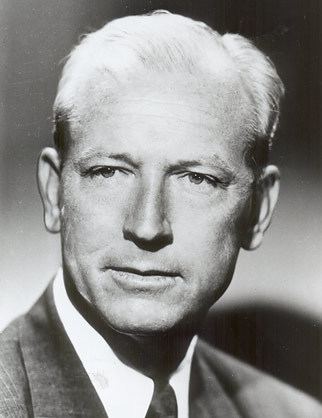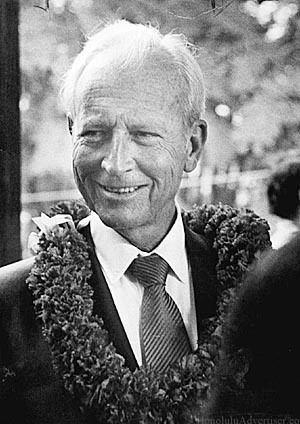Children JimJohnSheenagh Name John Burns Resigned December 2, 1974 | ||
 | ||
Lieutenant William S. RichardsonThomas GillGeorge Ariyoshi Preceded by Elizabeth P. Farrington Full Name Harry John Burns Spouse(s) Beatrice Van Vleet (nee) Education Saint Louis School, University of Hawaii | ||
New book to be released on hawaii s second governor john a burns
John Anthony Burns (March 30, 1909 – April 5, 1975) was an American politician. Burns was born in Montana and soon became a resident of Hawaii in 1923. He served as the second Governor of Hawaii from 1962 to 1974.
Contents
- New book to be released on hawaii s second governor john a burns
- An aura of greatness john a burns
- Early life
- Political career
- Governorship
- Later life and death
- Legacy
- References

An aura of greatness john a burns
Early life
John Burns was born in Fort Assinniboine, Montana on March 30, 1909. He was the eldest son of Anne and Harry Burns. Christened Harry John Burns, as a teenager he changed his name to John Anthony Burns. Burns’ father was in the Army and was ordered to Fort Shafter in Hawaii, so in 1913 he and his family moved to Hawaii, and eventually to Kalihi. Harry Burns became overwhelmed with responsibility for four children and left the family in 1919. Burns' mother became a launderer for Tripler Army Medical Center. Burns took care of his siblings and attended Saint Louis School, while his mother worked. She joined the Postal Service, and with the help of her brother, became postmaster for Fort Shafter and a clerk at the Honolulu Post office. In 1925 Anne sent John to live with her brother in Kansas, where Jack Scally served as a father figure. In Kansas he attended Immaculata High School in Leavenworth, then transferred to St. Benedict High School (now Maur Hill – Mount Academy) in Atchison. In 1927 Burns dropped out of high school and joined the Army, but did not like taking orders. He was honorably discharged after one year. Burns returned to Hawaii, waiting a semester to attend Saint Louis School and eventually graduate in 1930.
Political career
His work as a sympathetic police officer, building close ties with working class folks from numerous ethnic groups, notably Japanese and native Hawaiians. While a police officer in Honolulu, his first political efforts arose from his work with the Police Benevolent Society. From 1948 he led the Hawaii Democratic Revolution of 1954, through various leadership positions in the territorial Democratic Party, culminating in being chair of the territorial party in 1952. He is credited with building a coalition for the Democratic Party that included the Communist Party, 442nd Regimental Combat Team veterans, ILWU, other organized labor groups, and Japanese Americans to strengthen the party. In 1956, he was elected a party delegate from Hawaii. As a delegate, Burns played a key role in lobbying for Hawaii statehood, a goal that was achieved on March 12, 1959, when the statehood bill was signed by President Dwight D. Eisenhower. He sought to become the first governor of the newly formed state, but lost the election to Territorial Governor William F. Quinn.
Governorship
Three years later in 1962, Burns won the election to become governor. Governor Burns played a leading role in stimulating the state economy and attracting foreign tourism and investment. His many achievements include the promotion of Hawaii as a center for oceanography, construction of the new State Capitol building, and expansion of the University of Hawaii, helping to transform it into a first-class university, attracting students and faculty from around the world and early planning for the construction of the Aloha Stadium to host university football and bowl games. Burns supported the construction of an expanded Honolulu International Airport with a new reef-runaway and the construction of Interstate H-3.
Additionally, he supported planning for the future by establishing the Hawaii Commission on the Year 2000, which ultimately led to the development of the Quality Growth Policy for the State of Hawaii. Both the Commission on the Year 2000 and Hawaii's Quality Growth Policy were intended to supplement Hawaii's State Land-Use Plan. Finally, Governor Burns made Hawaii a leader in environmental management, establishing the Office of Environmental Quality Control, within the Governor's Office, to coordinate state environmental policy and to review environmental impact statements on all major state actions.
He was re-elected in 1966 and 1970, each time with a different lieutenant governor as his running mate.
Later life and death
Burns became ill from cancer to the point of incapacity in October 1973. Burns' third elected lieutenant governor, George Ariyoshi, became acting governor through the end of Burns' third term. Ariyoshi was elected in his own right as governor for the term beginning in 1974. Burns died on April 5, 1975 in Honolulu.
Legacy
The John A. Burns School of Medicine, at the University of Hawaii at Manoa, is named for him. In 1997, Governor Ben Cayetano named the newly completed Interstate H-3 in his honor, and the road to the summit of Mauna Kea is also named after him. A Hawaii golf tournament, comprising the best amateurs and PGA professionals in the state, was created in his honor. The Governor's Cup is a team event, and is played between the amateurs against the professionals. A special qualifier for the amateur team after the tournament will provide the medalist a chance to play in the Sony Open in Hawaii, a PGA Tour Event. The 2013 qualifier was Jared Sawada.
